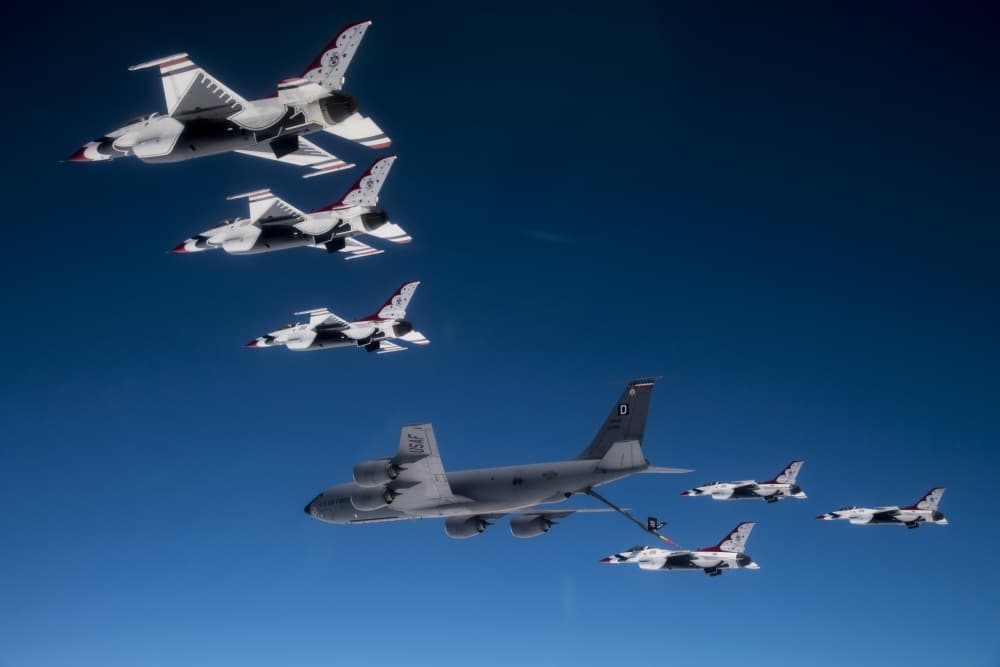PENSACOLA, Fla. — For the Navy’s Blue Angels and Air Force Thunderbirds traveling to an air show site may require performing an in-flight refueling maneuver to trim their flight time.
To get each squadron’s seven jets to an air show site requires their pilot to fly them. If the show site is in excess of their fuel comfort level, they preflight their planned stop at an military base for fuel, or sometimes, the fuel comes to them at nearly 350 m.p.h.
Aerial refueling began 95 years ago as one bi-plane delivered several gallons of fuel to another on a June afternoon. Today, hulking military aircraft are called upon as their sole job to refuel planes across the globe.
The Boeing KC-135R Stratotanker is the military’s largest flying gas station. For 60 years, it has been used to aerial refuel nearly all military aircraft. A typical KC-135 refueling flight carries a pilot, co-pilot, navigator, boom operator, and thousands of gallons of Shell JP-8 fuel stored for delivery.
The Blues Angels F/A-18 Hornet jets can travel approximately 1,000 miles on a full load of fuel without external tanks. For the squadron’s July 2018 flight from Pensacola to Oshkosh, Wisconsin to Fargo, N.D., their refuel arrived in flight.
One KC-135 based at the 434th Air Refueling Wing at Grissom Air Reserve Base in Indiana flew up on a planned rendezvous to load up the Blues thirsty jets. This refueling mission began near Nashville where the Blue Angels received their first refueling.

Much like a straw to a mouth, the KC-135’s boom is extended to an opening, and acts like a straw to funnel fuel directly into the tanks. Known as the probe-and-drogue refueling method, the flexible hose trails out from behind the tanker aircraft toward the positioned jet. A basket with a valve fitting is located at the end of the hose to grapple the jet’s fuel port.
In September, as the Blue Angels traveled cross country to California, and two KC-135R Stratotankers from Grissom met up to refuel the Hornets twice. Lying in the prone position, the boom operator carries out the hazardous operation with pinpoint accuracy.
“Normally most of what we do is out of the public eye – refueling aircraft,” Air Force KC 135 pilot Maj. Brandon German said. “But not only did we support the Blue Angels, we interacted with the public by participating in the air show – demonstrating our capabilities.”
The red, white, and blue F-16 Fighting Falcon jets of the Thunderbirds also rely on aerial refueling during extended flights. McConnell Air Force Base, Kansas, continues to assist the Thunderbirds several times a year.

“At any given time during their performance season, Team McConnell’s active duty and Reserve aircrews regularly perform aerial refueling for the team during performance season.” McConnell AFB spokesperson SSgt Abigail Klein stated from a windy tarmac preflight. “McConnell’s KC-135 Stratotanker aircrews are regularly part of the (Thunderbirds) worldwide journey.”
During 2019, the Thunderbirds will put some heavy mileage of their F-16s as they travel to 35 show sites, visiting three locations outside the Continental 48 states. In July, the Thunderbirds will travel some 6,440 miles round trip to Rionegro, Colombia for their international air show.
One month later, the Thunderbirds will travel some 2400 miles RT to British Colombia, Canada for the Abbotsford air show. And, the squadron will fly still fly another 6400 miles to San Juan for the Puerto Rico air show.
“The F-16 is one of the easiest of the fighters to refuel, but they also move fast, so it is something you really have to pay attention to,” McConnell KC-135 boom operator MSSgt. James Yokom said.
One example of an in-flight refueling mission occurred in November 2017, as McConnell AFB assisted the Thunderbirds on a 1200-mile non-stop flight from their home at Nellis AFB, Nevada to San Antonio, Texas.

“During the more than four-hour flight, the KC-135 aircrew offloaded more than 4,477 gallons of fuel and made 12 successful contacts with the (six) jets,” SSgt Klein explained.
The numbers of each refueling flight varies. In February 2018, the T-Birds traveled from Nellis cross country to Florida for their annual Daytona 500 flyover. High above Mississippi, McConnell’s KC-135 flight crew made some 22 contacts with the boom with the six aircraft.
“The aircrew spent approximately an hour refueling the team, offloading 8,850 gallons of fuel during their five-hour flight to Daytona,” SSgt Klein added.
(Charles A Atkeison reports on aerospace and technology. Follow his updates via social media @Military_Flight.)









